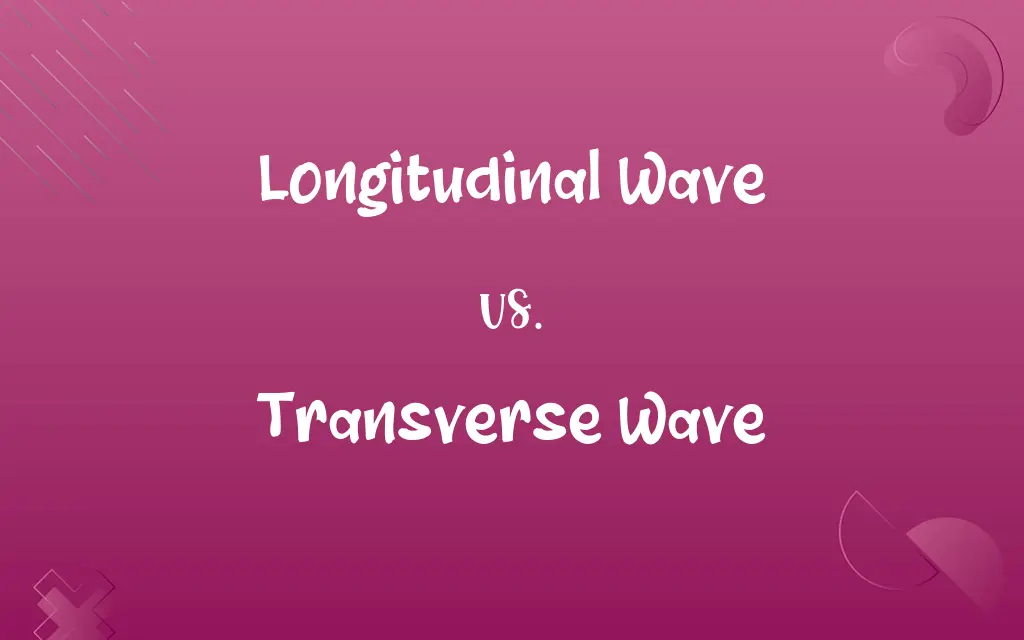Longitudinal Wave vs. Transverse Wave: Know the Difference

By Shumaila Saeed || Updated on December 25, 2023
A longitudinal wave oscillates parallel to its direction of travel (like sound waves), while a transverse wave oscillates perpendicular to its direction (like light waves).

Key Differences
A Longitudinal Wave is characterized by particle oscillations parallel to the direction of wave travel. In contrast, a Transverse Wave exhibits oscillations perpendicular to the wave's direction.
Shumaila Saeed
Nov 16, 2023
Longitudinal Waves compress and expand the medium they travel through, like in sound waves. Transverse Waves, however, move up and down or side to side, as seen in electromagnetic waves.
Shumaila Saeed
Nov 16, 2023
Examples of Longitudinal Waves include sound waves and seismic P-waves. For Transverse Waves, light waves and seismic S-waves are typical examples.
Shumaila Saeed
Nov 16, 2023
Longitudinal Waves require a medium (solid, liquid, or gas) to travel. Conversely, Transverse Waves can travel through vacuums, as evident in electromagnetic radiation.
Shumaila Saeed
Nov 16, 2023
In terms of energy transfer, Longitudinal Waves transfer energy in the same direction as the wave. Transverse Waves transfer energy perpendicular to the direction of the wave.
Shumaila Saeed
Nov 16, 2023
ADVERTISEMENT
Comparison Chart
Direction of Oscillation
Parallel to wave direction.
Perpendicular to wave direction.
Shumaila Saeed
Nov 16, 2023
Medium Requirement
Requires a medium (solid, liquid, gas).
Can travel through a vacuum.
Shumaila Saeed
Nov 16, 2023
Movement in Medium
Compression and expansion of the medium.
Up and down or side to side movements.
Shumaila Saeed
Nov 16, 2023
Energy Transfer
In the direction of the wave.
Perpendicular to the wave direction.
Shumaila Saeed
Nov 16, 2023
ADVERTISEMENT
Longitudinal Wave and Transverse Wave Definitions
Longitudinal Wave
A wave with oscillations parallel to its direction of travel.
Sound waves traveling through air are longitudinal waves.
Shumaila Saeed
Nov 10, 2023
Transverse Wave
Transfers energy perpendicular to the wave's direction.
In the transverse wave, the energy moved sideways relative to the wave's path.
Shumaila Saeed
Nov 10, 2023
Longitudinal Wave
Transfers energy in the same direction as the wave movement.
The energy of the longitudinal wave moved along the direction of the wave.
Shumaila Saeed
Nov 10, 2023
Transverse Wave
A wave with oscillations perpendicular to its direction of travel.
Light is a transverse wave with perpendicular electric and magnetic fields.
Shumaila Saeed
Nov 10, 2023
Longitudinal Wave
Commonly found in acoustic and seismic applications.
Seismic P-waves, a type of longitudinal wave, provide clues about the Earth's interior.
Shumaila Saeed
Nov 10, 2023
ADVERTISEMENT
Transverse Wave
Common in electromagnetic and seismic phenomena.
Seismic S-waves, a form of transverse wave, shake the ground side-to-side during earthquakes.
Shumaila Saeed
Nov 10, 2023
Longitudinal Wave
A wave causing compression and rarefaction in the medium.
The longitudinal wave in the spring compressed and expanded the coils.
Shumaila Saeed
Nov 10, 2023
Transverse Wave
Capable of traveling through a vacuum.
Transverse waves like radio waves travel through the vacuum of space.
Shumaila Saeed
Nov 10, 2023
Longitudinal Wave
Requires a physical medium to propagate.
In a longitudinal wave, the disturbance traveled through the solid rod.
Shumaila Saeed
Nov 10, 2023
Transverse Wave
Exhibits up and down or side to side movement.
The waves on the water's surface were transverse, moving up and down.
Shumaila Saeed
Nov 10, 2023
Repeatedly Asked Queries
What is a Transverse Wave?
A Transverse Wave is a wave with particle motions perpendicular to the direction of wave propagation.
Shumaila Saeed
Nov 16, 2023
Can Transverse Waves travel in a vacuum?
Yes, Transverse Waves like light can travel through a vacuum.
Shumaila Saeed
Nov 16, 2023
Do Longitudinal Waves require a medium?
Yes, Longitudinal Waves require a physical medium to propagate.
Shumaila Saeed
Nov 16, 2023
What is the energy direction in a Longitudinal Wave?
In a Longitudinal Wave, energy moves in the same direction as the wave.
Shumaila Saeed
Nov 16, 2023
How do Longitudinal Waves travel through mediums?
Longitudinal Waves travel by compressing and expanding the medium.
Shumaila Saeed
Nov 16, 2023
Are sound waves Longitudinal or Transverse?
Sound waves are Longitudinal Waves.
Shumaila Saeed
Nov 16, 2023
How do Transverse Waves move in a medium?
Transverse Waves move the medium up and down or side to side.
Shumaila Saeed
Nov 16, 2023
What mediums do Transverse Waves travel through?
Transverse Waves can travel through solids and vacuums, but not through fluids.
Shumaila Saeed
Nov 16, 2023
What is a Longitudinal Wave?
A Longitudinal Wave is a wave where particles of the medium move in the same direction as the wave.
Shumaila Saeed
Nov 16, 2023
Is energy movement in a Transverse Wave parallel to the wave?
No, in Transverse Waves, energy movement is perpendicular to the wave's direction.
Shumaila Saeed
Nov 16, 2023
Can Longitudinal Waves be polarized?
No, Longitudinal Waves cannot be polarized, unlike Transverse Waves.
Shumaila Saeed
Nov 16, 2023
How do Longitudinal and Transverse Waves differ in speed?
Typically, Longitudinal Waves travel faster in the same medium compared to Transverse Waves.
Shumaila Saeed
Nov 16, 2023
What is an example of a Transverse Wave?
Light waves are an example of Transverse Waves.
Shumaila Saeed
Nov 16, 2023
Can both wave types be found in earthquakes?
Yes, earthquakes produce both Longitudinal (P-waves) and Transverse (S-waves) waves.
Shumaila Saeed
Nov 16, 2023
Why can't Transverse Waves travel through gases?
Transverse Waves require a medium's rigidity, which gases lack, for perpendicular oscillations.
Shumaila Saeed
Nov 16, 2023
Can Longitudinal Waves be visualized?
Longitudinal Waves can be visualized using slinkies or springs to demonstrate compression and rarefaction.
Shumaila Saeed
Nov 16, 2023
Are seismic P-waves Longitudinal or Transverse?
Seismic P-waves are Longitudinal Waves.
Shumaila Saeed
Nov 16, 2023
What instruments detect Transverse Waves?
Instruments like photodetectors and radio antennas detect Transverse Waves.
Shumaila Saeed
Nov 16, 2023
What are seismic S-waves?
Seismic S-waves are Transverse Waves that move the ground side-to-side.
Shumaila Saeed
Nov 16, 2023
How are Longitudinal Waves detected?
Longitudinal Waves, like sound, are detected by instruments like microphones or the human ear.
Shumaila Saeed
Nov 16, 2023
Share this page
Link for your blog / website
HTML
Link to share via messenger
About Author
Written by
Shumaila SaeedShumaila Saeed, an expert content creator with 6 years of experience, specializes in distilling complex topics into easily digestible comparisons, shining a light on the nuances that both inform and educate readers with clarity and accuracy.









































































